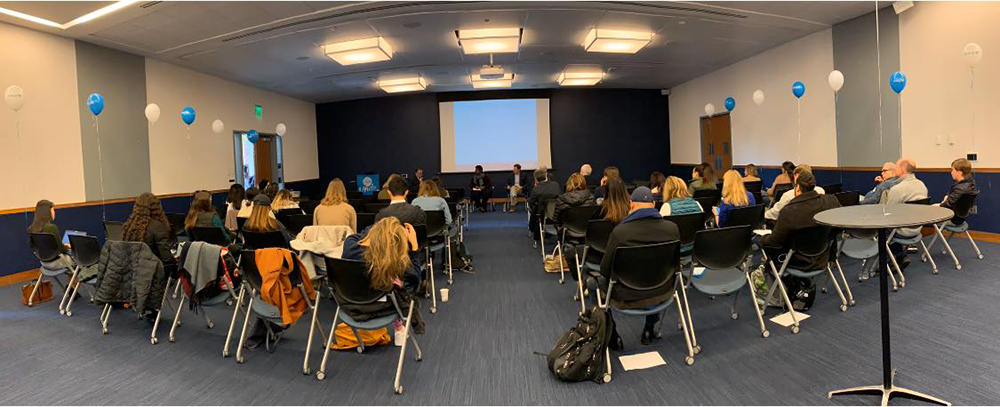UNICEF-Georgetown hosted the 17th annual International Children’s Development Conference on Nov. 10, which focused on the effect of gang violence on the migration of children from Latin and Central America to the United States.
This year’s conference aimed to bring awareness to the narratives of Latin and Central American children, who often are targeted by gangs in their home countries and led to immigrate to the United States to escape violence, according to UNICEF-Georgetown Co-President Joy Yue (SFS ’21).
“People rarely address how these issues’ negative impacts disproportionately affect children and youth, especially in the Central and Latin American region, where many children are purposefully targeted by/recruited into gangs and as a result seek to migrate to the US to escape from violence and reunite with family,” Yue wrote in an email to The Hoya.

The first of two panels at the conference featured discussion around advocacy and policy work on the effect of gang violence, including a conversation on family separations and legal advocacy for unaccompanied children. The second panel included discourse on the immigrant journeys of panelists Juan Pacheco, director of the community development coalition Barrios Unidos DMV, and Elizabeth Guzman (D), a member of Virginia’s House of Delegates, to showcase the diversity of experiences of immigrants moving to the United States.
The conference comes after the recent migrant caravan, a group of thousands of migrants from Guatemala, Honduras and El Salvador who in late 2018 traveled to the U.S.-Mexico border to escape poverty and violence. Migrant children who reached the U.S.-Mexico border were held in poor living conditions and often separated from their families, according to The New York Times.
The UNICEF-Georgetown board chose the focus for this year’s conference in light of the migrant caravan and the poor treatment of children at the U.S.-Mexico border, according to Yue.
“A significant number of children were among the caravan, vulnerable to the instabilities along the journey,” Yue wrote. “Therefore the Board approved this topic because we thought it was timely, relevant, and urgent for us to address.”
The first panel on advocacy and policy work featured Miriam Abaya, a policy associate at the Young Center for Immigrant Children’s Rights, Mark Engman, managing director of policy and advocacy at UNICEF USA, and David Murphey, director of the ChildTrends Data Bank.
In addition to the other obstacles immigrant youth face in their journey to the United States, migrant children face obstacles in accessing mental health resources to address traumatic life experiences, which can lead them to be more vulnerable to gang recruitment, according to Abaya.
“They’ve suffered trauma in their home country before they left on their journey to the United States, and some of them have now suffered trauma at the hands of our government,” Abaya said during the panel. “They’re going back to communities that don’t have the mental health support in order to help them recover from that trauma. All of that can make kids more vulnerable, of course, to gang violence and gang recruitment.”
Competing political narratives on immigration prevent effective policy solutions to the issue of gang violence for young immigrants, according to Engman. To adequately protect migrant children’s rights, politicians must work to depolarize rhetoric and address concerns about immigration, according to Engman.
“We have competing narratives that are preventing us from coming to solutions, and it’s global,” Engman said. “We have to get away from heated rhetoric and really talk about the issues and the fears that people have and how we can address those fears while still protecting children’s rights.”
Alongside the struggles and hardships they have faced throughout their immigration, each migrant child’s experience contributes to American culture through the diverse narratives and perspectives each individual brings to the United States, according to Murphey.
“We have to move beyond stereotyping and generalizations and understand that there are all kinds of stories behind every immigrant child or family member that comes to this country,” Murphey said in an interview with The Hoya. “They’re not all the same, but those who do come often have remarkable stories of resilience, survival and they bring those assets to our culture — if they simply make it here — and they contribute enormously to society.”
The advocacy work of the panelists showcased the progress being made toward helping individuals impacted by violence and immigration obstacles, according to Yue.
“Moreover, by inviting a full panel of experts and practitioners on the issue, we also want to give hope to our community by emphasizing that this challenge may not be going away anytime soon, but we are lucky enough to have advocates who are passionate about engaging with these issues and working towards making meaningful positive change,” Yue wrote.




















